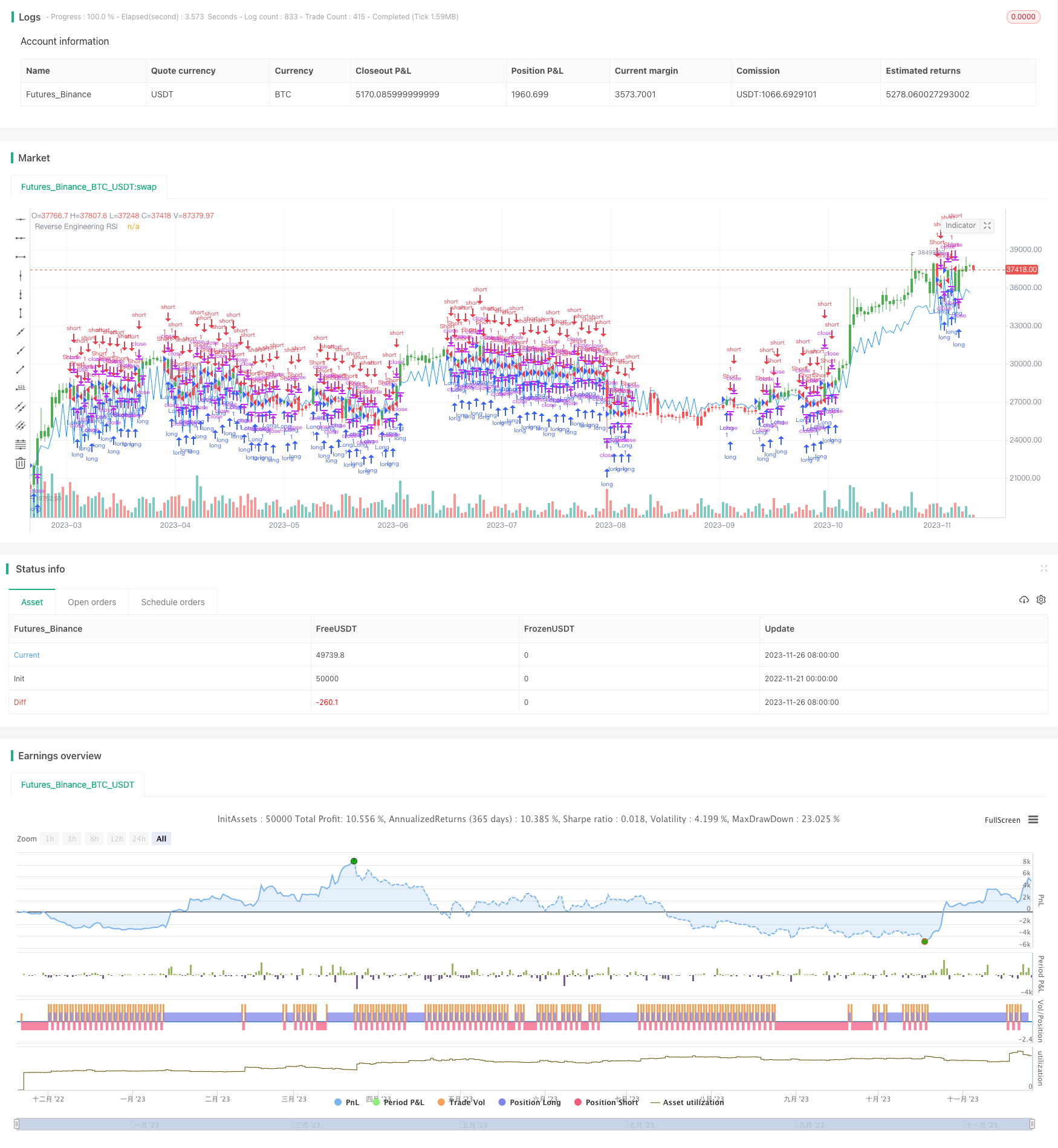
概述
逆向工程RSI策略是一种基于RSI指标的交易策略。该策略通过模拟RSI指标的计算过程,反向推导出价格,从而产生交易信号。
策略原理
该策略的核心思路是:
计算RSI指标中的K值、ExpPer周期、AUC上涨序列和ADC下跌序列。
根据RSI的参数设置、ADC、AUC序列值等反向计算得到nVal。
根据nVal加到价格上,反向求得nRes。
比较nRes和当前close价格,产生长仓和短仓信号。
具体来说,策略首先计算出RSI中的一些关键参数,包括K值、ExpPer周期、AUC上涨序列和ADC下跌序列。其中,K值为平滑因子,ExpPer为RSI参数设置的两倍减1。
然后根据这些参数,策略反向推导价格。首先计算一个关键变量nVal,它等于(WildPer - 1) *(ADC_ Value / (100 - Value) - AUC)。 该公式反向推导RSI的计算过程。
接着将nVal加到当前close价格上,得到反向工程的价格nRes。 最后,如果nRes高于当前close价格则产生短仓信号,如果nRes低于当前close价格则产生长仓信号。
优势分析
该策略主要有以下优势:
利用RSI指标的计算过程进行逆向推导,思路新颖,具有一定的创新性。
反向工程价格,产生与市场相反的交易信号,可以实现做空的效果,扩大了策略的应用范围。
RSI是一种成熟和常用的交易指标,参数设置合理,可靠性较高,风险较低。
策略思路清晰易懂,参数较少,易于实现,适合量化交易的要求。
风险分析
该策略也存在一些风险:
反向工程价格仅仅依据RSI计算,如果RSI发出错误信号,则策略信号也会失效。
反向信号与市场总体走势可能不一致,需要关注大市场的环境。
RSI参数设置需要经验,如果不当可能导致过于频繁交易或发出错误信号。
反向操作做空风险高,需要严格的资金管理,防止爆仓。
可以通过优化RSI参数,结合其他指标,严格资金管理来控制风险。
优化方向
该策略可以从以下几个方面进行优化:
优化RSI的参数WildPer和Value,使其更好地适应市场行情。
增加止损策略,以锁定利润,减少亏损。
结合其他指标如MACD进行优化,使信号更加准确可靠。
添加开仓过滤条件,避免不必要的失误交易。
优化资金管理策略,严格控制单笔交易的资金量,防止超出可承受损失。
总结
逆向工程RSI策略通过反向推导RSI指标的计算过程,生成与市场相反的交易信号。该策略思路独特,具有一定创新性,可以实现做空,扩大策略应用范围。但也存在反向操作的风险,需要进行适当优化和风险控制。总体来说,该策略为量化交易提供了新的思路和工具。
/*backtest
start: 2022-11-21 00:00:00
end: 2023-11-27 00:00:00
period: 1d
basePeriod: 1h
exchanges: [{"eid":"Futures_Binance","currency":"BTC_USDT"}]
*/
//@version=2
////////////////////////////////////////////////////////////
// Copyright by HPotter v1.0 25/10/2017
// The related article is copyrighted material from
// Stocks & Commodities.
//
// You can change long to short in the Input Settings
// WARNING:
// - For purpose educate only
// - This script to change bars colors.
////////////////////////////////////////////////////////////
strategy(title="Reverse Engineering RSI, by Giorgos Siligardos", overlay = true)
Value = input(50, minval=1)
WildPer = input(14,minval=1)
reverse = input(false, title="Trade reverse")
ExpPer = 2 * WildPer - 1
K = 2 / (ExpPer + 1)
AUC = iff(close > close[1], K * (close - close[1]) + (1 - K) * nz(AUC[1], 1), (1-K) * nz(AUC[1], 1))
ADC = iff(close > close[1], (1-K) * nz(ADC[1], 1), K * (close[1] - close) + (1 - K) * nz(ADC[1], 1))
nVal = (WildPer - 1) * (ADC * Value / (100 - Value) - AUC)
nRes = iff(nVal >= 0, close + nVal, close + nVal * (100 - Value) / Value)
pos = iff(nRes > close, -1,
iff(nRes < close, 1, nz(pos[1], 0)))
possig = iff(reverse and pos == 1, -1,
iff(reverse and pos == -1, 1, pos))
if (possig == 1)
strategy.entry("Long", strategy.long)
if (possig == -1)
strategy.entry("Short", strategy.short)
barcolor(possig == -1 ? red: possig == 1 ? green : blue )
plot(nRes, color=blue, title="Reverse Engineering RSI")